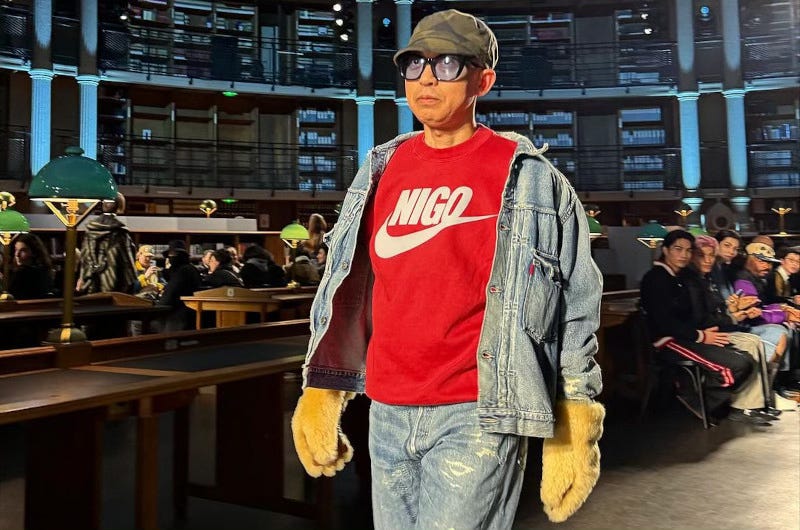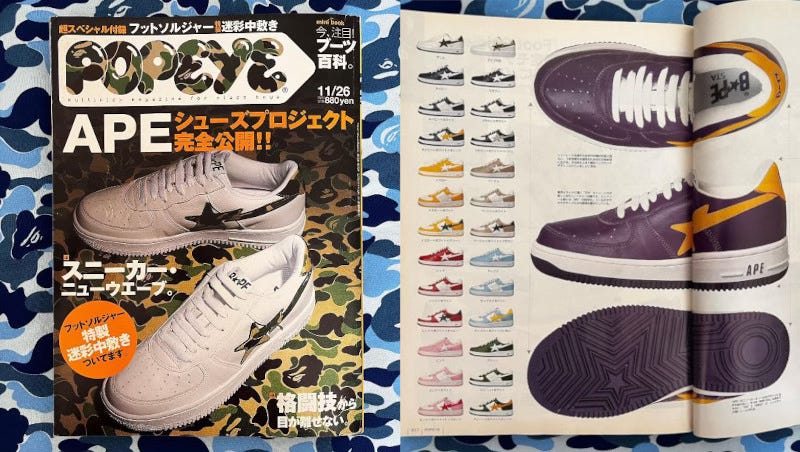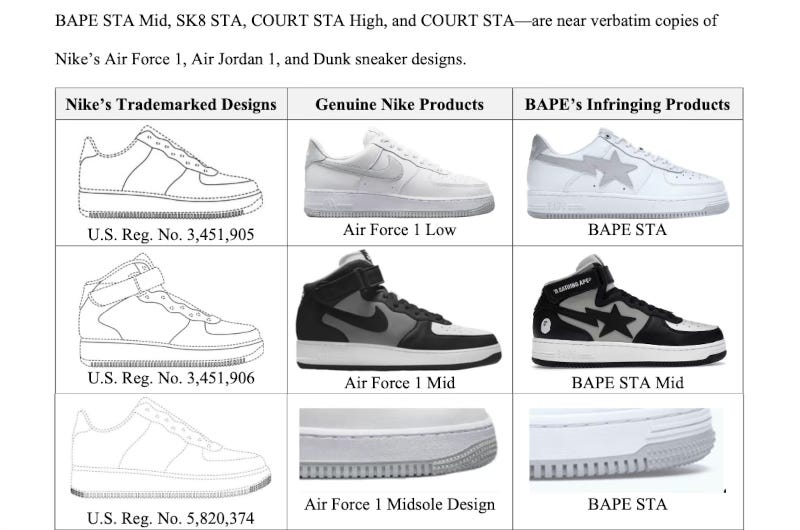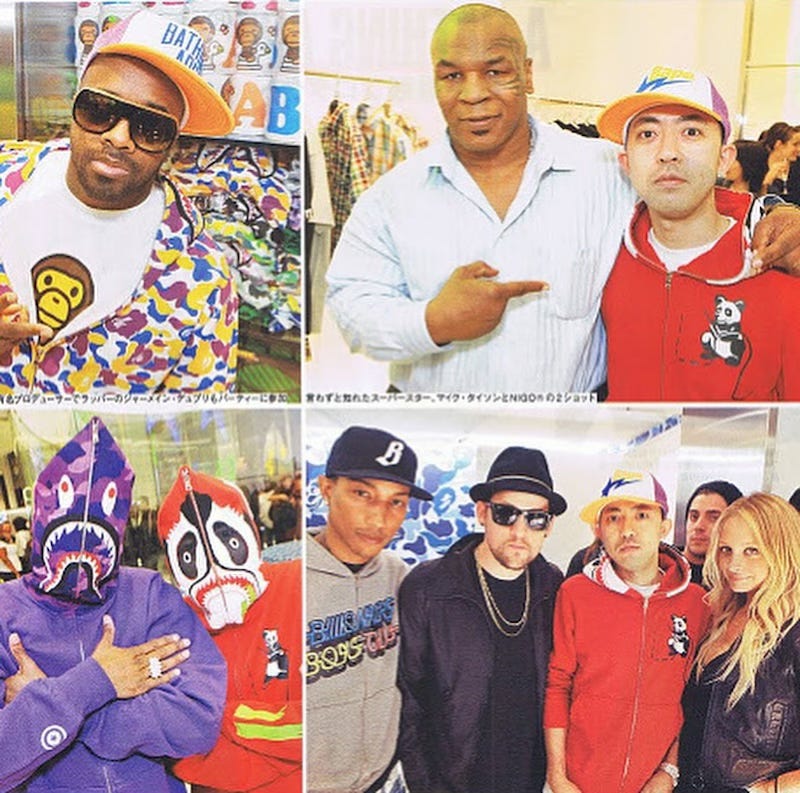It finally happened: NIGO publicly acknowledged his partnership with Nike. The Japanese designer – born Tomoaki Nagao – was first reported to have signed a deal with the Oregon-based sportswear company in April 2023. The news sent shockwaves across streetwear and sneaker-focused corners of social media because, if true, it meant NIGO’s 20-year history with adidas had come to a close. Neither party shared details of a split, but spectators began to speculate once several seasons passed without new collections. The Human Made and A BATHING APE founder all-but-confirmed the report when he was pictured wearing the Nike Go FlyEase.
No big deal, right?: Loyalty and business rarely mix, let alone last for two decades. Wrong!: NIGO rocking anything with a swoosh was huge not only because he had been collaborating with the Three Stripes since 2003, but also (perhaps most importantly) because one of his most iconic designs of all-time – the BAPE STA – was heavily inspired by Nike’s beloved Air Force 1 Low.
Whispers from behind-the-scenes have long claimed that NIGO once pitched the Swoosh the idea of offering Air Forces in as many color combinations as possible and in materials other than leather. A deal couldn’t be agreed upon, so the BAPE frontman allegedly decided to take matters into his own hands.
NIGO announced the opening of Foot Soldier in the Nov. 2001 issue of Popeye Magazine. A footwear-focused branch of A BATHING APE, Foot Soldier NIGO-fied sneaker retail with its conveyor belt displays, gallery-like lighting, and refined architecture. The shop’s biggest draw, however, was the dozens of footwear options. Only a handful of different silhouettes were offered at launch – including a style based on the adidas Superstar – but they were available in an array of colors seldom offered by the heritage brands. NIGO thought it was important to have variety, exploring a mix of bold and subtle color arrangements.
The BAPE STA was offered in 40 different makeups upon debut. “It is also good to be troubled with the choice of colors,” NIGO told Popeye. At the time, most of Nike’s readily-available selection skewed straightforward and familiar. Most experimental pairs of the Air Force 1 were reserved for limited collaborations and region-exclusive drops. In its earliest days, NIGO’s BAPE STA was difficult to obtain outside of Tokyo and Hong Kong, but it was offered in a plethora of “flavors” all year round. One such set of flavors was glossy, neck-cracking, attention-grabbing patent leather.
Nike, Inc. was no stranger to this material. Back in 1995, Tinker Hatfield featured a patent leather rand on the Air Jordan 11, a move informed by Michael Jordan’s desire for a “shiny basketball shoe.” Bruce Kilgore, however, designed the Air Force 1 High and Low over a decade earlier, sticking to the design principles and budgetary restrictions of his time. Leather was king amongst basketball shoes of the 1980s. And while Kilgore’s creation was rooted in performance, it was quickly replaced by more advanced footwear. The Air Force 1 became a fashion staple across Baltimore and New York City from the late ‘80s onwards, but it regained some spotlight on the hardwood around the turn of the century thanks to Rasheed Wallace.
In conversation with Matt Barnes and Stephen Jackson on the All the Smoke podcast, Wallace shared that he’d been a fan of Nike Air Forces since his days growing up in Philadelphia. The decision to play basketball in them, however, arose after dealing with numerous twisted ankle injuries throughout high school and college. Wallace’s Nike representative throughout the early 2000s, Nico Harrison, helped him get special editions of his “weapon” of choice. A two-tone high-top done in Portland Trailblazers-friendly “Black/White” made its way onto retail shelves, allowing brave souls to try and dominate the paint in the big man’s Air Force 1. Interestingly enough, the pair was constructed with patent leather, a material that had never been associated with Kilgore’s design from ‘82. Insight into patent leather’s use has never been publicized by any party involved, but it’s possible the glossy material was chosen to match Wallace’s bold personality on the court. The Philly-native was also in tune with style, often rocking his Air Force 1 Highs with the ankle straps dangling at the back – the same way they were being styled in major cities across the country. Regardless of the reasoning behind the patent leather, Nike’s shiny sneakers coincided with NIGO’s launch of the BAPE STA.
Those “in the know” were aware of BAPE STAs and their similarity to Kilgore’s design, but valued their design tweaks and color variety enough to celebrate them as NIGO’s creation and not simply a knock-off Nike. Internet spaces like NikeTalk helped the star-featuring shoe gain a following in the West before the first BAPE Store opened up in New York City in 2004. It’s likely Nike was aware of the BAPE STA before then, but not concerned enough about it given the sneaker’s (and BAPE’s) small-scale relevance outside of Japan, and relative limited production. Additionally, as reported by Complex, Nike hadn’t registered a trademark to protect the Air Force 1’s trade dress until 2008, meaning it couldn’t enforce ownership of any of the model’s visual aspects before.
A lawsuit filed on Jan. 25, 2023 in New York district court revealed that Nike representatives met with leadership at BAPE in 2009 to address similarities between the Air Force 1 and BAPE STA. On the legal front, nothing came from the meeting, but BAPE “significantly and materially diminished its US activities,” according to Nike’s lawyers in the suit. Shortly after, NIGO announced he had sold most of his shares in BAPE to I.T., a Hong Kong-based fashion conglomerate. “The General” agreed to stay on as Creative Director until 2013, but had already been working on another lifestyle project named Human Made.
On Feb. 25, 2014, adidas took to Twitter to announce a long-term partnership with NIGO. The deal made sense given previous work between both parties; the streetwear pioneer also shared that a friend of his had joined the Three Stripes around the same time and invited him to work with the sportswear giant. NIGO’s adidas fandom had been well-documented prior to his first linkup with the brand in ‘03, but his BAPE STA naturally begged the question of why he didn’t take his talents to Nike. Longtime mentor, Hiroshi Fujiwara, former schoolmate and business partner, Jun Takahashi, and a host of other folks in his extended circle were also at the Swoosh in the early 2010s so NIGO would fit right in. Perhaps the meeting from ‘09 left tension between both parties; maybe NIGO saw Nike as “crowded”; or perhaps he wanted creative freedom and was privy to Nike’s strictness (Yeezy might’ve taught him). Whatever the backstory, the duo seemed right, and the decision to make things official 10 years later arguably confirms both parties agree. But we aren’t in 2014 anymore.
NIGO’s importance to streetwear and sneakers cannot be undermined. His designs dominated the early aughts, and his display of taste and curation inspired the likes of Virgil Abloh. Folks from a younger generation are familiar with The General, but widely by way of a conduit (e.g. Lil Uzi Vert, Pharrell Williams, Tyler, the Creator). Their relationship, then, is largely limited to one of unquestioned respect rather than informed admiration. BAPE’s resurgence throughout the last handful of years has also made all-over camo print hoodies and STA-donning footwear bigger than their original designer. No Human Made project launched in the same time span (in-line or collaborative) made any noise comparable to NIGO’s work at A BATHING APE, lowering his stock amongst teenagers and young adults.
Why, then, would Nike want to work with him? It’s unlikely either party will ever publicly share the complete truth, but what can’t be denied is that NIGO should’ve gotten his shot years ago.
(While it’s possible NIGO was the one to delay working with Nike, it’s arguably improbable due to some of the aforementioned points. Furthermore, NIGO’s use of the Air Force 3 Low in the “Escape” color scheme from ‘88 earlier this year suggests he was thinking about the Swoosh while working with the Three Stripes as the pair bears a resemblance to an adidas Originals Rivalry High he designed in 2014.)
NIGO’s partnership has come at a low point for Nike. In June, the brand’s stock price dipped by 14-percent following a late-month earnings call. Beyond any stock market ticker, the Swoosh had been experiencing wide-scale criticism from savvy consumers over saturation of products like the Air Jordan 1, Dunk, and Air Force 1. Casual customers have also turned their attention to footwear styles either not offered by the brand (e.g. Crocs Classic Clog) or “more innovative” and “cooler” than Nike’s (e.g. On Cloud 5). The North American company has been rather reactive to trends, too, scrambling to respond to trendy styles like the adidas Samba, ASICS GT-2160, and New Balance 860v2. Special, limited pairs from the past have also either been retrod or reported to return in 2025 by reputable sources, leading many spectators to judge the brand for rehashing the past instead of looking forward.
And that’s the biggest indictment against NIGO x Nike: it’s a trip down memory lane that’s a decade too late.
If you take a few minutes to read comments under teaser images of the partnership’s debut capsule, you’ll notice there’s an overwhelming negative sentiment towards NIGO x Nike. Yes, first-looks are commonly received worse than official photos and campaign material, but poor lighting and bad angles haven’t been problems. Most criticism thus far has revolved around three ideas:
The Air Force 3 Low is a tough sell.
“Air Forces in BAPE STA colors” was right there!
Who cares about NIGO in 2024?
All valid points, no?
The last time Nike reissued NIGO’s canvas-of-choice was in 2015. “Shoe dogs” and nostalgia merchants rejoiced at the return of the widely-unheralded model, but the retro did little to energize decades-old design. NIGO’s name and likeness has already done more for the silhouette than Nike has since the late ‘80s, but consumers haven’t responded very favorably to the brand’s old school, low-top models: the Swoosh’s response to the New Balance 550’s explosion in popularity largely failed, making the Air Force 3 Low a questionable choice.
We’ll never know how hard NIGO pushed for the 36-year-old silhouette, but his decision aligns with some of his new partner’s recent collaborations – including Union Los Angeles’ Nike Field General. Additionally, the first official ad about NIGO x Nike revealed how personal the project was to the Japanese designer, whom, according to the ad, injected his favorite “movies, music, and traditions of craft” into the collection.
A series of Nike Air Forces in BAPE STA-reminiscent colors done by NIGO could’ve meant something, similar to Virgil Abloh’s official Louis Vuitton x Nike collaboration. Some spectators would’ve undoubtedly scoffed at the “easy” play, but the move would’ve been a cheeky acknowledgement by the Swoosh – a company that’s gone on a suing spree over trademark infringement in the last few years – of NIGO’s genius. The product’s rollout could be legendary, too.
How surreal would it be to see dozens of “NIKE STA” pairs displayed on conveyor belts at a pop-up recreation of Foot Soldier? The youth could learn about NIGO’s influential career in the process. But maybe this would be putting NIGO in a box…
The General has always been a man of few words, at least when engaged with Western media. And when he does speak, he’s a lot more soft-spoken than some of Nike’s biggest collaborators. Currently Artistic Director at KENZO, NIGO is plugged in with the creative world at a high level. His name might not draw the same crowds as “Travis Scott,” but his following is full of tastemakers and shakers that have been at it for years. Taking a step back from early product shots, the NIGO x Nike partnership has been celebrated by many of the BAPE founder’s peers as “a full circle moment.” The Swoosh might’ve tapped NIGO to soak up some of his cachet, as well as benefit from his expansive streetwear knowledge.
As proven by smaller brands than Nike, collaborations by newcomers and lesser-known faces have the possibility to pop, as long as the product and rollout are undeniable, and the launch fair.
NIGO and Nike shouldn’t have a problem with their execution; on the contrary, they have the experience and resources to show the industry how collaborations should be done. NIGO’s network of “Friends & Family” is also expansive, meaning hype for his debut capsule with the Swoosh could reach levels that haven’t been seen since Abloh’s “The Ten” collection from 2017.
With summer winding down, the inaugural collection from NIGO and Nike inches closer. There’s no telling how the drop will go – nor how the partnership will pan out – but the world will be watching.










